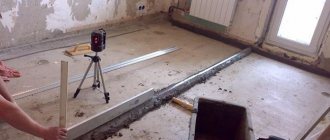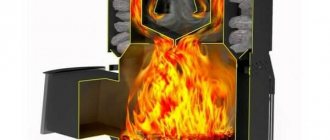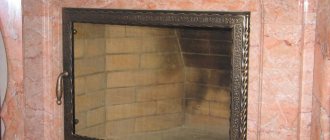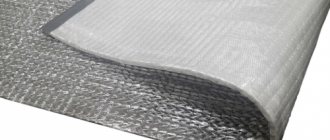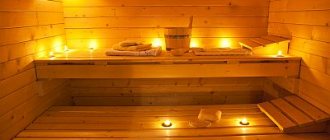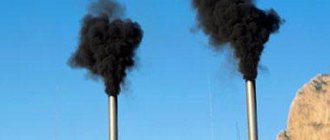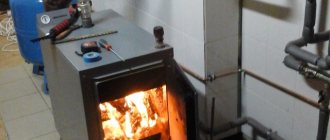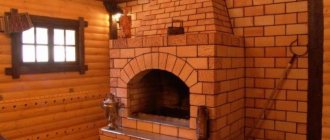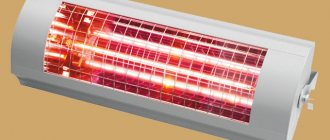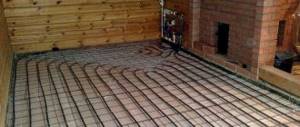The bathhouse in Rus' has always been not only a place for washing, but also a unique place for communicating with friends and a home hospital for various ailments. For heating a bathhouse, firewood was always chosen that had a fragrant, tart aroma of forest and various resins. A lot of firewood is wasted. The main means for a bath that saves wood is the ability to heat a sauna stove. And one of the most important conditions for saving firewood is the quality of the fuel.
A couple of phrases about calorific value
In terms of its chemical composition, wood is a rather complex material. It contains the main components - lignin and cellulose. But besides them, the tree contains:
- resins;
- proteins;
- tannins and other ingredients.
When logs burn in a stove (or simply when trees burn in a forest), these components interact with the air at a chemical level. The calorific value of wood (as well as any fuel), or thermal conductivity, is the amount of thermal energy that a unit of weight of the fuel material (in our case, 1 kg of wood) produces during combustion. Kilocalories are used to measure quantities.
The chemical composition among most tree varieties has minimal variations, which causes differences in the number of calories emitted. That is, the heat of combustion of some types of firewood can be as follows:
- for deciduous species the figure is 4460 kcal/kg;
- for coniferous species - 4560 kcal/kg;
- for mixed breeds – 4510 kcal/kg.
As you can see, the differences are minimal. At the same time, it is easy to understand that it is better to use coniferous wood for the stove due to its greater thermal conductivity. Only firewood is supplied to the market depending on volume, not weight. That is, the main criterion for choosing firewood is cubic meters. Density plays an important role here, because the higher it is, the heavier the wood.
For example, let’s take 1 cubic meter of birch logs as a starting point. Then the ratio of the volume of different rocks will look like this:
- oak logs - 0.75 cubic meters. m;
- alder logs - 1.1 cubic meters. m;
- pine logs - 1.2 cubic meters. m;
- spruce logs - 1.3 cubic meters. m;
- aspen logs - 1.5 cubic meters. m.
That is, 1 cubic meter of birch and 0.75 cubic meters. m of oak logs, 1.1 cubic meters. m of alder wood (and so on) will produce the same amount of heat. Knowing this, now, depending on how much firewood costs, you can get profitable savings for yourself.
This is important to know!
Regardless of the type of trees that will be used for firewood, you need to know about some features:
- Deadlines. Of course, those logs that have already served their “allotted” time will also burn (provided that they are dry and there is no mold on them). However, most trees retain their aroma only for two years. Alder and aspen are a pleasant exception in this regard - 3 years.
- Everything has its time. In winter, the humidity of trees is at a minimum level. In this regard, the preparation of firewood must be done during this period. Drying usually takes about 12 months. However, the timing depends on the type of forest, harvesting time, storage conditions and a number of other factors. In this case, the duration may increase significantly or, conversely, decrease.
- Dimensions. Which firewood is more profitable? Of course, those with optimal sizes. And these are 40-50 cm in length and 8-10 cm in thickness. This is how they are convenient to store and are suitable for any firebox.
- Rot. Under no circumstances should you use rotten firewood. Keeping logs on the ground for a long time results in the accumulation of toxic substances released during combustion, which is not beneficial to humans. For this reason, when cutting down branches, you should immediately take the correct measures to store them. When choosing raw materials for heating among dead wood, you should not take into account long-fallen branches.
- Storage issues. Logs should be laid with the bark facing up. This will protect the firewood from accidentally entering moisture, which evaporates faster from the surface of the bark. And if you show your imagination, you can build an original woodpile to the delight and surprise of your guests.
As can be seen from this material, it is not enough to know which firewood is best for the stove. It is equally important to ensure that they are stored correctly.
Regarding the arrangement of a woodpile, you can always come up with a lot of different ideas: from the most creative and crazy to the simplest to implement.
Breed characteristics
The dense structures of deciduous trees are suitable for producing good heat in the firebox. They burn brightly, generating a lot of heat in the process. The trunks of fruiting trees smell pleasant when burned, which makes them indispensable in fireplaces and open hearths.
The smell of smoldering mass depends on the content of esters, resins, and tanning components. Oak releases tart tannins, rosewood scents the space with vanilla, and backout feels about the same.
Coniferous trees have an intense flame, but when burning they emit more smoke than deciduous trees. When using them, the walls and ceiling of the room, as well as the inside of the chimney, become clogged faster. The smell of turpentine, which comes from pine and spruce, spreads into the room.
Oak in the hearth
Initially, oak is considered as a valuable wood for production, so discarded trunks or measured waste are used for fuel. If we talk about full-fledged logs, their cost is high, so such options are rarely used.
It is better to burn with wood cut from middle-aged and not very old trunks. This guarantees long combustion and release of a large amount of energy. Young specimens give off a not too intense heat, and the room in the house has the smell of smoldering wood. Old trunks will leave a lot of ash in the residue, while the energy released is weaker.
Burning quality logs releases a tart aroma with added forest notes. It tones the body, relaxes the nervous system and has a beneficial effect on health. Oak wood is completely suitable for fireplaces and stoves.
Linden for bath
When burned, linden wood produces an even heat throughout the entire process. This is the kind of combustion that is required when heating steam rooms and baths. The raw material is used to maintain uniform temperature in the heating compartment.
Linden firewood emits a sweetish odor that is beneficial for the respiratory organs. It is difficult to ignite raw materials in the firebox, so torches and thin logs are used. Firewood is stored for two years, then its properties begin to decline. The calorific value of linden firewood is 2040 kcal, which is not enough to fully heat a house. Sometimes fuel is used in stoves for cooking.
Birch logs
In terms of density, birch is equal to oak, therefore it is a high-quality fuel for stoves. Its ability to transfer heat is lower than that of valuable wood, but is a quarter higher than that of coniferous trees. When burned, the raw material gives an even flame and does not emit sparks. In terms of calorific value, a cubic meter of birch firewood replaces:
- 1.15 m³ alder, pine;
- 1.3 m³ spruce;
- 0.76 m³ oak logs;
- 1.52 m³ aspen.
The disadvantage is the admixture of resin in the wood, most of which comes from the bark of the trunk.
Logs are placed in the stove, after removing the top layer. The soot released during smoldering clogs the chimney and narrows the working channel of the exhaust gases. When burning birch fuel, a unique smell is felt; volatile substances disinfect the atmosphere and prevent respiratory infections in households. By analogy with linden, birch is stored for only two years.
Softwood firewood: pine, spruce, larch
By the characteristic crackling of the logs, which literally caresses the ear, and the bright scattering sparks, you can determine the combustion of pine logs. They give off a lot of heat, but burn out quite quickly. But many shortcomings are quickly forgotten thanks to the unique resinous aroma that comes from burning pine or spruce firewood. Only in this case you should be extremely vigilant, since sparks shooting out from time to time can cause a lot of trouble. Therefore, it is necessary to observe safety precautions.
It is worth noting that pine logs produce more heat than spruce logs. Largely due to the high content of resinous substances, due to which the above-mentioned aroma is released. Pine and spruce, it produces an equally invigorating effect. In addition, it can have a tonic effect on the organs of the upper respiratory tract. In addition, spruce logs have a “shooting” effect, while pine firewood has a smoke effect. But the wood of both species splits and melts easily, although it smokes heavily.
As for larch, rarely does anyone light a firebox with such wood due to its low prevalence. It should be taken into account that when logs burn, carbon monoxide is released in large quantities. For this reason, you should not immediately close the damper, and your country house or country cottage should have high-quality ventilation.
Peat
Often you have to decide what to heat the stove with besides wood. We have to abandon this excellent type of fuel for some completely objective reasons. Alternatively, peat and coal briquettes can be considered. Despite the fact that their nature of origin is the same, their properties and calorific value are different.
In order for fuel to be used directly, it often has to be pre-treated, dried, crushed, or chopped. Peat contains a lot of water inside, so it needs to be dried. But when dried, it crumbles and becomes not so much unusable as inconvenient to use. Therefore, it is pressed with the addition of sawdust into special briquettes.
The main parameter for each type of fuel is its specific heat of combustion. It shows how much useful energy can be obtained if a fixed amount of fuel is completely burned.
Peat in a crumbly state
For peat in various variants, this value does not exceed 17 MJ. However, we cannot evaluate some physical quantities by their absolute value, so for comparison we present a fragment of the table of values.
Ready-to-use peat briquettes
The amount of heat in MJ released by the following types of fuel:
- coal - 27.00;
- brown coal - 12.98;
- anthracite coal - 28.05;
- peat - 12.10;
- peat in briquettes - 17.58;
- peat in the form of crumbs - 10, 84.
Peat in large briquettes
Coal
Coal is of natural, not man-made origin. In some regions of Russia, coal is mined, which is enough not only to supply the domestic market, but also for sale abroad.
Good to know: How to properly heat a stove with coal, basic rules
But coal is divided into several types, which differ in the age of its formation. It is not difficult to guess that higher quality rocks differ in the duration of their occurrence in the layers. There are three types of coal classification, although the same grades are involved in each.
- Classification by formation time. In this division, four types of coal are distinguished: lignite, brown and hard coal, and anthracite coal. These breeds are listed in order of increasing age. They also differ in physical properties. Lignite is presented in the form of crumbs, since it is not able to hold its shape. Brown coal is also not very durable, but it can already be used in home stoves. Although its calorific value is far from its analogues. Hard coal is the most common and accessible type, and anthracite is considered the highest quality rock.
- Classification by humidity and content of volatile compounds. In this gradation, known rocks follow the same sequence. Their humidity decreases from 40% to 5%. A similar picture emerges with volatile substances. In this division, anthracite occupies an advantageous position.
- Classification by calorific value. We had to introduce the calorific value parameters earlier, so it makes no sense to duplicate the indicators. It should only be emphasized that this classification is decisive when choosing fuel for a home stove.
Features of furnaces using coal
The vast majority of real stove models that we remember from our grandparents were adapted to use wood and coal. This averaging of the design was carried out on purpose, because it was difficult to predict what would have to be used to heat the stove in each specific season. However, if you take a detailed approach to the construction of the furnace, then these options should differ.
The temperature inside the firebox when burning coal is much higher than when burning wood. This leads to the fact that the walls of the metal firebox are strengthened using thicker sheets. The volume of the firebox increases due to the lower location of the grate. The ash pit is built to be larger in volume, since the amount of ash when using coal is much greater than that of firewood.
Getting ready to light the oven
How to properly heat a stove with coal, wood and other fuels in the house - instructions and recommendations
In addition to fuel, preparatory work should be carried out and special tools should be purchased.
Required materials and tools
In order to make the furnace fire safe and comfortable, special devices and tools were invented. With their help, a whole set of simple actions are performed to ensure conditions for normal operation of the furnace.
- Axe. One of the most ancient instruments. With its help, houses were built and firewood was collected. Using an ax, it is good to chop wood of the required size and cut wood chips.
- Poker. An indispensable tool for laying and screwing firewood (or other fuel) into the stove. This handy poker is made of metal but has a wooden handle. It comes in different lengths, which should be selected in accordance with specific operating conditions. A properly selected poker should easily penetrate between the grates to clean it from ash.
- Metal scoop. Needed for regular cleaning of the oven. The size of the scoop is selected based on the size of the blower - the shovel should fit freely into the opening of the blower door.
- Metal tongs. A very convenient tool that allows you to manipulate all the hot parts of the stove - the doors of the firebox, the ash pan, the wood basket in the fireplace, etc.
- Grip made of heat-resistant material. As a rule, it is made in the form of a mitten for the right or left hand. It differs from a regular mitten in that it is made of materials that are resistant to combustion and do not conduct heat well. The grip is protected on top by a special fiberglass fabric and filled with heat-resistant cotton wool inside. With its help, you can safely move the valves on the chimney without fear of getting burns. A high-quality grip is made of a material to which soot practically does not stick.
- Metal bucket. Serves to clean the ash cavity from ash and ash.
Set of tools and accessories for the fireplace
Fire safety rules for the operation of stove heating and preparatory work
In order for the stove to serve for many years and not cause trouble, certain rules must be followed. They were “invented” by life itself, which forces us to treat the stove not only as a source of heat, but also as a potentially dangerous unit. Careless handling of fire can lead to disastrous and even tragic consequences.
Folk sign. If in a house heated by a Russian stove, the next morning your eyes become watery or sour (as with conjunctivitis), it means carbon monoxide is seeping through the cracks in the stove. The stove needs repair. And until it’s done, you can’t leave the heat in the stove overnight; you can only heat it during the day. It is recommended to ventilate the room before going to bed.
First of all, the stove must be in good working order; there should be no cracks, sagging or poorly closing doors. The furnace pipe must comply with the standard dimensions. It is best to cover the floor in front of the firebox with a metal sheet. The recommended size is 1 m from the blower door. Firewood should be stored out of the area of possible ignition.
You need to light a fire with small wood chips, birch bark, and paper. Starting with low heat, gradually bring the oven to operating mode.
It is strictly forbidden to use flammable liquids such as gasoline, alcohol, or diesel fuel for ignition. It is acceptable to use dry alcohol in tablets.
Dry alcohol in tablets
Before each new firebox, the cavity of the combustion chamber, grate bars and the space of the ash compartment must be cleared of ash and ash. Only under this condition will the oven function optimally.
The chimney should be cleaned at least once a year.
If the stove has been idle for a long time, the first time it needs to be prepared for regular heating. To do this, paper is burned in the firebox. You need to burn it until there is a stable draft in the chimney. Views and shutters should be as open as possible. The blower is covered, the thrust is created by the nozzle of the fuel chamber.
Video: how to light a brick stove at the dacha
Only after this should the main portion of firewood be laid. Laying methods can be varied, but the basic rule is that the distance between the logs should be such that air can freely flow around the fuel from all sides. Usually this is about 1–2 cm. In this situation, the firewood begins to burn together, releasing maximum heat.
Correct placement of firewood in the firebox is the key to long service life of the stove.
How to properly heat a stove with wood: the “black” method
At the beginning of lighting the stove, the amount of firewood is small, just enough to get stable coals. Approximately, this should be a layer 30–35 cm from the grate plane. If the kindling is made with peat or granulated briquettes, the layer may be smaller - about 15–25 cm.
If the combustion process has become stable, the next portion can be added only when the fuel has burned down to 50%.
Premature intervention (scooping, adding new firewood, etc.) can extinguish the flame of the fire.
When laying a new portion of firewood, it is recommended to completely close the vent so that smoke does not penetrate into the living area. As the chimney warms up and a stable draft forms, the ash door is gradually closed.
The color of the flame can be a good guide. The best heat transfer rates will be when the fire emits a light yellow color. If the color is red, it means the combustion temperature is low. The firewood may not have been dried enough. A white glow indicates excessive draft, similar to that created in a forge using bellows. In this case, you can close the blower door or reduce the cross-section of the pipe using a valve or view. Combustion at high temperatures leads to the fact that the heat, without having time to warm up the heat exchanger, flies into the open space of the street.
Optimal combustion mode of wood in the furnace firebox
In order to increase the efficiency of the furnace unit, you should carefully monitor the position of the doors and valves. Thus, it has been experimentally established that when the combustion door is not closed, up to 45% of the heat evaporates into the surrounding external environment. The door is only 1 mm poorly closed. reduces furnace efficiency by 10%. Therefore, always after adding fuel, it is necessary not only to close the door, but to close it tightly using locking mechanisms. Among other things, this will help prevent sparks from flying from the firebox into the living area, which is likely to lead to a fire.
The duration of combustion of the stove depends on the type of fuel used.
When using wood-burning materials, it is recommended to fire for 1–1.5 hours. The approximate temperature of the furnace walls is optimal in the range of 75–85 degrees. Higher temperatures have a negative impact on the masonry, leading to the gradual destruction of bricks and binder mortar.
If the combustible material is coal, the burning time of which is longer, the whole process is extended to 2.5–3 hours. During this time, the stones should completely burn out, only the non-combustible part of them, the so-called ash, will remain in the firebox.
The combustion process ends after the combustible materials have completely burned out. Evidence of this is usually the absence of a blue final flame, in which the residual carbon monoxide burns. At the final stage, it is recommended to clean the firebox and ash pan, close all doors tightly and reduce the draft in the pipe to a minimum using valves. If everything is done correctly, the stove will give off heat to the living space for a long time, maintaining a comfortable air temperature.
Secrets of lighting a stove
Many people tend to mistakenly evaluate fuel by the ease of its ignition. It will not be possible to light coal without firewood; in addition, the ignition process itself must be carried out correctly. This contributes to a long service life of the stove.
The stove must be inspected externally every time you intend to light it. Substances or objects that are easily flammable and were accidentally placed nearby are first removed to a sufficient distance. Before kindling, the chamber and ash pan must be cleaned, removing unburned food. To prevent small particles of ash from flying around the room, it is recommended to pour a little water into the ash pan.
Household waste containing plastic or bitumen cannot be used for kindling, as they cause the formation of large amounts of soot in the chimney. The firebox door and the ash pan should not be open in pairs. This rule is useful, since when kindling you have to adjust the draft.
Coal is usually stored indoors, but moisture may not be excluded. In this case, it must first be dried. When wet coal is burned, all the water in the form of steam goes up the chimney. A large amount of soot settles on the wet surfaces of the pipe walls.
Crumpled old newspapers are placed on the grate. Small wood chips can be placed on top of them. Wood logs are stacked in a hut or a well, depending on your habits. After this, we light the stove by closing the firebox door and opening the ash pan.
When the firewood begins to burn out and the first hot firebrands form, you can add a portion of small coal, after which larger pieces are gradually added. When burning coal, you should close the chimney damper, this will save heat. But remember that when the damper is closed, there is a high probability of filling the room with carbon monoxide. Watch the flame, a blue tint indicates that it’s time to open the damper.
Furnace condition
An important indicator of the quality of heating the premises in the house is the condition of the stove, since heat loss will depend on this. For example, if there is even a small gap between the combustion chamber door and the brick wall of the furnace, then the efficiency of the heating unit is reduced by 10 percent.
After all, cold air from the room will enter the gap, which will increase draft, that is, the heat generated in the firebox will fly out into the chimney. And if you forget to close the firebox door when lighting, the heat loss will be significant, and the efficiency of the stove will decrease by 40 percent.
To reduce heat loss, it is recommended:
- before the start of the heating season, repair the stove, sealing all cracks and gaps found during inspection;
- clean the chimney at least twice during the heating season;
- do not be lazy to remove the ash and clean the grate before each kindling;
- The stove, which is made for heating, should be heated at least a couple of times a day. The oven should not overcool; this should not be allowed. If this happens, it may lose traction. Before burning, first burn the newspaper in the firebox, and this must be done after closing the ashpit. At first, smoke will be released, and when stable combustion begins, this will be a signal that traction has appeared and you can load a portion of firewood. If the oven has not been used for a long time, you will have to do this several times.
Primary requirements
The best firewood for heating stoves is dry. Humidity should be within 20%. This is the main requirement. The calorific value of wood depends very much on its moisture content.
Dry wood flares up and burns well, emits more heat, and smokes less. The logs should not be rotten or saturated with water. Water logs are not suitable for heating stoves.
Good firewood leaves little ash. It is advisable to harvest wood in late autumn or winter, when sap flow stops and the wood is denser.
The size of firewood for the stove depends on the size of the firebox, usually 35-40 centimeters long. The thickness is medium, thick logs split. Small logs are easy to light. They also burn quickly, which must be taken into account when preparing them.
So what is firewood?
If you think about what firewood is and look in the “free encyclopedia”, it turns out that firewood is simply pieces of wood intended to be burned in the firebox of a stove or fireplace, to obtain heat and light, but how else? After all, when burning, heat and light are released at the same time. To do this, they need to be prepared. The next question arises: how to prepare firewood?
You cannot heat the stove with wet wood! When burning a stove with raw wood, the stove does not heat well and smokes. When burning raw wood, most of the energy is spent on drying the fuel itself, and what is left will be used to heat the walls of the stove. It is difficult to heat the stove with damp wood. An open fireplace will most likely not work at all. Smoke will not go up the chimney. Also, heat-resistant mixtures, adhesives and pastes often do not withstand exposure to moisture and are destroyed very quickly. This leads to rapid destruction of the furnace, and repairing the furnace is difficult and expensive. Also, when burning raw wood, you will spend many times more money, but you will receive less heat. Excess moisture can destroy the chimney masonry, saturating it with unburned fuel combustion products. For example, tar may be released on a brick chimney when fired with damp birch. The pipe becomes soaked through, releasing a pungent odor. To prevent this from happening, heat the stoves with dry wood. Dry and store them properly!
How to prepare firewood?
A freshly cut tree has very high humidity. Especially during the period of movement of juices in the trunk. Therefore, it is advisable to harvest firewood during a period of the year when the movement of sap stops and the tree contains as little water as possible. This time is autumn and winter. In spring, the movement of juices begins again. The cycle repeats. In winter it is easier to reach those places where there is a lot of water in summer, autumn and spring. Plots for cutting trees for firewood are most often provided in such places.
Rare types of firewood
Oak
– the best firewood for the stove. The wood is dense, burns for a long time, gives high heat transfer, and is very economical, because compared to other firewood, much less is consumed to heat the same area. Due to its high cost, it is often used as an additive to other wood. A pair of oak logs will make the burning more intense and longer.
Good oak firewood comes from middle-aged trees; when burned, they release a pleasant tart aroma. Oak firewood is ideal not only for stoves, but also for fireplaces.
Excellent, but also one of the most expensive - alder
firewood. They burn hot, without smoke or soot, spreading a pleasant aroma.
Alder cannot be confused with any other firewood; when cut, it has a color from yellow to deep red. Perhaps this is the best firewood for a fireplace; it burns with a mesmerizing, even flame of a beautiful color. A big plus is that alder firewood lasts a long time and can be stored for future use for 5-6 years.
Rare firewood includes linden
. Although linden is common, linden firewood is rare. The wood is hot, although it takes a long time to burn, but then the stove heats up very quickly. The aroma that comes from linden when burned has healing properties. A bathhouse heated with linden firewood is useful for colds, diseases of the bronchi and lungs, and has a beneficial effect on the condition of the skin.
Regardless of what type of firewood you purchase, make sure that the wood is not rotten. The benefits of rotten mushrooms are zero. In order for the wood to burn, giving off maximum heat, it must be dry. Undried wood burns poorly, produces a lot of smoke and little heat.
For thousands of years, our ancestors used wood (firewood) as fuel. And today, despite the widespread use of natural gas or coal, they remain a popular type of fuel.
Folk tales
Superstitions and beliefs circulate among the people. For example, it is believed that it is better to prepare firewood for a bath during the waning moon. Moreover, the thinner the sickle, the stronger the logs are endowed with healing powers. Once upon a time, the Slavs believed that people who left the world turned into maples in their lives. The appearance of its leaves is akin to open palms, and its branches represent hands raised to the heavens. For this reason, they never fired maple stoves.
In the old days, residents of the Tambov province heated their stoves exclusively with apple trees to keep the house warm throughout the winter, including especially frosty days. Whether to believe all this or not is everyone’s business, but what happened was what happened.
Which ones are best for the oven?
Any wood can be used as fuel. The main thing is that they exist. Each region has its own preferences, depending on what trees grow in the area. Many people believe that birch or alder are the best. The choice is yours.
To the bathhouse
The choice of logs for heating a sauna depends on the design of the stove. Many people prefer:
- Alder. They produce a persistent heat and burn almost smokelessly. There is a popular belief about their healing power;
- Birch. Burns evenly, the heat is strong;
- Willows. The heat transfer is low, you will need a lot of them, but the spirit in the bathhouse will be especially light.
It is not recommended to use oak ones - they take a long time to burn out, the heat is intense, and they emit a large amount of carbon monoxide. Periodically, aspen is used to clean the chimney. If the furnace firebox is remote, the main selection criterion is heat transfer.
For home heating
Hardwood firewood has the best qualities and is used more often. Birch, oak, linden - any, depending on their availability and needs. The main thing is to be dry. In fireplaces it is better to use those types that smoke less and do not “shoot”.
What is better to heat and what to choose: pros and cons of different types of fuel
There are the following types of fuel for stoves and fireplaces:
- natural gas;
- hard and charcoal;
- diesel fuel;
- firewood, wood briquettes and pellets;
- peat and others.
The choice of a specific type of fuel depends on many factors. These include the region of residence, the area of the premises, the type of boiler or furnace equipment. In addition, different types of combustible materials have different costs, which also affects the final result. If the house is located in a wooded area where there is a lot of natural wood material, there is no point in heating it with expensive imported coal or diesel fuel. And, conversely, in regions where coal is mined, but with a steppe landscape, it makes more sense to use coal.
Each type of fuel has its own advantages and disadvantages. This table shows the most characteristic properties of combustible materials from the point of view of convenience and safety of their consumption.
Table: comparative characteristics of various fuel materials
| Fuel | Minuses | pros |
| Wood fuel | Lengthy process of preparation and storage. Requires special storage space. | High environmental performance. An inexhaustible, renewable resource. Availability. Natural product. Not an expensive price. Explosion safety. |
| Coal | The price is higher than that of firewood. Requires special storage space. The need to dispose of combustion waste (ash). Complex kindling process. | The combustion temperature and efficiency are higher than that of firewood. Relatively inexpensive fuel. Explosion-proof. Compactness. |
| Natural gas | The need to install complex equipment that requires constant maintenance. Mandatory periodic replacement of worn parts. The price is higher than electricity. There may be gas leaks leading to explosive situations and fire. Poisonous to humans. | Ease of use. Versatility (serves both for heating the room and for other household needs). Does not require storage space. If there is a highway, it does not require procurement and delivery. Cheaper than wood and coal. |
| Electricity | High price. Consumption restrictions. Dependence on natural phenomena (wind, storms, snowfalls). Dangerous to human health and life. | Ease of use. Waste-free operation. Ecological cleanliness. |
| Diesel fuel | Requires a fuel line or tank to store fuel. Supports combustion. Has a persistent characteristic odor. High price. | High combustion temperature and efficiency. Autonomy. Possibility to make large reserves. Inexpensive equipment to use, no permits or inspectors. |
| Wood chip briquettes | Requires storage facilities, transportation and loading and unloading operations. | Ease of use. Affordability. Explosion safety. Waste-free process for heating your home. |
Among other things, combustible materials can be compared in terms of their coefficient of performance (efficiency).
Table: Efficiency of various energy carriers
| Type of fuel | Gross efficiency (%) |
| Electricity | 97,0 |
| Gas | 87,1 |
| Wood pellets | 86,0 |
| Diesel fuel | 81,6 |
| Wood chips, dry sawdust | 80,5 |
| Fuel oil | 72,6 |
| Coal | 56,1 |
| Firewood | 49,5 |
| Peat | 38,6 |
| Raw wood sawdust | 35,1 |
The vast majority in our country uses firewood. Despite some disadvantages, firewood belongs to the category of renewable fuels and its resource in the forest zone is practically inexhaustible. Therefore, we will consider the main characteristics of this unique and affordable type of fuel in more detail.
First of all, you need to know that different types of wood produce different amounts of heat when burned. This is due to the density of the wood itself and the amount of moisture contained in them. For example, tree species such as willow, linden, poplar, and aspen contain a lot of bound water, and drying takes a long time (up to 2 years when stored under natural conditions). Procuring them as fuel is not recommended.
The best raw materials for firewood are oak, pine, larch, and birch. Apple, pear and cherry trees burn well, but they are not harvested on an industrial scale. The table below shows data reflecting the calorific value of various tree species.
Table: calorific value of firewood from various tree species
Different calorific values for different types of wood
An important indicator of the effectiveness of firewood is its degree of dryness.
Wood moisture content is considered optimal not exceeding 25%. Raw, freshly cut wood has a moisture content of about 60%. Drying in natural conditions (under a canopy that protects the warehouse from precipitation) lasts from 1 to 1.5 years, depending on the region and climatic conditions.
In this regard, granulated wood briquettes have a significant advantage, which during the manufacturing process undergo forced drying in industrial dryers.
Video: making a sawdust press
Video: do-it-yourself briquettes for heating stoves
The best of the best: fruity, birch and linden
This list is also supplemented by fruit trees: pear, apple tree.
They emit a pleasant aroma and burn well, but it is difficult to make kindling with any hard logs. Birch and linden are considered the best for heating a stove. Birch has a low amount of moisture even in its raw form. Logs can be placed in the firebox without drying, they will still give off great heat and will smolder for a long time. Linden is valued for its healing properties. If you heat the stove with linden wood, you will have a healing microclimate in your house or bathhouse. Linden burns slowly, with good heat transfer. Thus, the best varieties are hardwoods, and of these, birch and linden.
Softwood
Soft varieties of wood melt quickly, but require drying to a residual moisture of 20% and proper storage. These include coniferous varieties. Disadvantages: large amount of resins, high sparkle (with an open firebox the fire hazard increases). As a rule, common types are used: pine and spruce. They are easy to chop and saw, the cost of purchasing this firewood is quite low.
Exotic
As you know, there are quite a lot of tree species, and to list all their types, you could write a thick book, or even more than one.
Therefore, in addition to the varieties listed, it is worth touching on at least a few more:
- Elm. It produces a lot of smoke, is difficult to split and takes a long time to ignite.
- Poplar. Like firewood for a stove - nothing at all. They prick easily, just scatter sparks and burn quickly.
- Beech. It is also difficult to light and split, but can be used raw.
- Fir. Like poplar, it is easy to prick and ignite, but you cannot do without a lot of smoke and sparks.
- Sycamore. Wood is easy to kindle, but difficult to split.
Can they be used for heating in a stove? Everyone can find the answer to this question themselves. But, on the other hand, why not?!
How to store it correctly?
To maintain the quality of firewood for a long time, you need to ensure proper storage. No special conditions are required for this; a number of points need to be taken into account:
- The woodpile should not be located in a low place where water can accumulate. Otherwise, the wood may rot.
- Logs should be stacked loosely to ensure good ventilation.
- To provide protection from precipitation, a canopy is made.
- There is no need to stack firewood immediately after harvesting. It's better to do this in a few months.
- It is recommended to store it near the house so that there are no difficulties with access to the woodpile.
How much does firewood cost?
How much firewood for a stove costs is a question that worries those who do not have the opportunity to prepare it themselves. Their price depends on many factors: wood type, region of residence, humidity, packaging (can be bought in nets).
The price range is wide - from 500 rubles per 1 cubic meter to 3,000 rubles. You will also have to take into account the cost of their delivery. The issue of price is also important for those who prepare it themselves. Self-harvesting is often more expensive if you count the costs of material resources, time, and your own labor.

